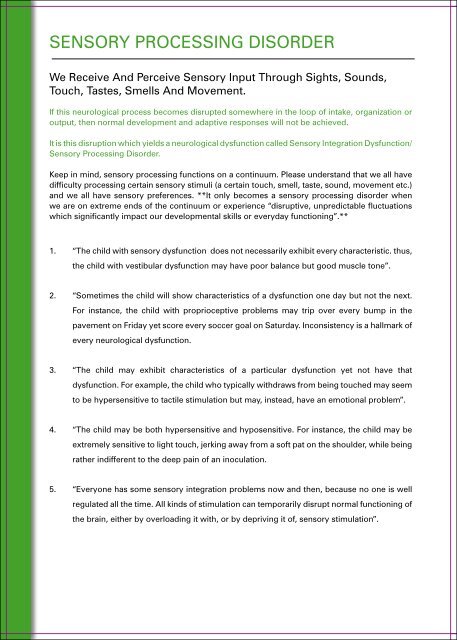PDA_Booklet
PDA_Booklet
PDA_Booklet
Create successful ePaper yourself
Turn your PDF publications into a flip-book with our unique Google optimized e-Paper software.
SENSORY PROCESSING DISORDER<br />
We Receive And Perceive Sensory Input Through Sights, Sounds,<br />
Touch, Tastes, Smells And Movement.<br />
If this neurological process becomes disrupted somewhere in the loop of intake, organization or<br />
output, then normal development and adaptive responses will not be achieved.<br />
It is this disruption which yields a neurological dysfunction called Sensory Integration Dysfunction/<br />
Sensory Processing Disorder.<br />
Keep in mind, sensory processing functions on a continuum. Please understand that we all have<br />
difficulty processing certain sensory stimuli (a certain touch, smell, taste, sound, movement etc.)<br />
and we all have sensory preferences. **It only becomes a sensory processing disorder when<br />
we are on extreme ends of the continuum or experience “disruptive, unpredictable fluctuations<br />
which significantly impact our developmental skills or everyday functioning”.**<br />
1. “The child with sensory dysfunction does not necessarily exhibit every characteristic. thus,<br />
the child with vestibular dysfunction may have poor balance but good muscle tone”.<br />
2. “Sometimes the child will show characteristics of a dysfunction one day but not the next.<br />
For instance, the child with proprioceptive problems may trip over every bump in the<br />
pavement on Friday yet score every soccer goal on Saturday. Inconsistency is a hallmark of<br />
every neurological dysfunction.<br />
3. “The child may exhibit characteristics of a particular dysfunction yet not have that<br />
dysfunction. For example, the child who typically withdraws from being touched may seem<br />
to be hypersensitive to tactile stimulation but may, instead, have an emotional problem”.<br />
4. “The child may be both hypersensitive and hyposensitive. For instance, the child may be<br />
extremely sensitive to light touch, jerking away from a soft pat on the shoulder, while being<br />
rather indifferent to the deep pain of an inoculation.<br />
5. “Everyone has some sensory integration problems now and then, because no one is well<br />
regulated all the time. All kinds of stimulation can temporarily disrupt normal functioning of<br />
the brain, either by overloading it with, or by depriving it of, sensory stimulation”.


